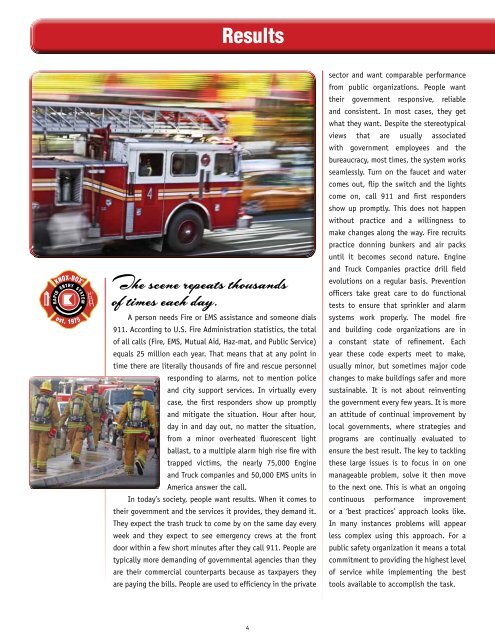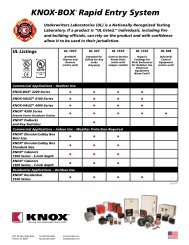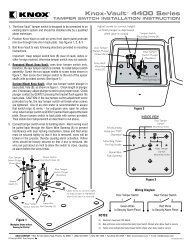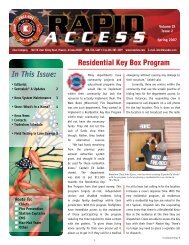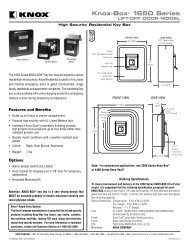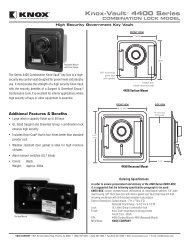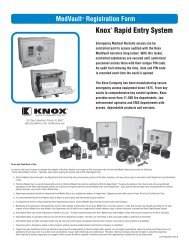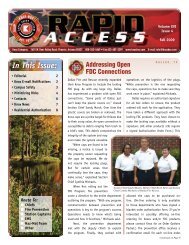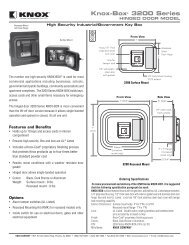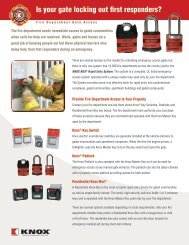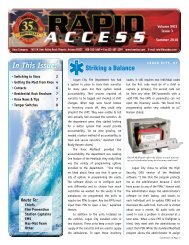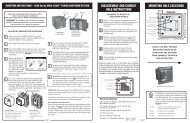In This Issue: - Knox Box
In This Issue: - Knox Box
In This Issue: - Knox Box
You also want an ePaper? Increase the reach of your titles
YUMPU automatically turns print PDFs into web optimized ePapers that Google loves.
ResultsThe scene repeats thousandsof times each day.A person needs Fire or EMS assistance and someone dials911. According to U.S. Fire Administration statistics, the totalof all calls (Fire, EMS, Mutual Aid, Haz-mat, and Public Service)equals 25 million each year. That means that at any point intime there are literally thousands of fire and rescue personnelresponding to alarms, not to mention policeand city support services. <strong>In</strong> virtually everycase, the first responders show up promptlyand mitigate the situation. Hour after hour,day in and day out, no matter the situation,from a minor overheated fluorescent lightballast, to a multiple alarm high rise fire withtrapped victims, the nearly 75,000 Engineand Truck companies and 50,000 EMS units inAmerica answer the call.<strong>In</strong> today’s society, people want results. When it comes totheir government and the services it provides, they demand it.They expect the trash truck to come by on the same day everyweek and they expect to see emergency crews at the frontdoor within a few short minutes after they call 911. People aretypically more demanding of governmental agencies than theyare their commercial counterparts because as taxpayers theyare paying the bills. People are used to efficiency in the privatesector and want comparable performancefrom public organizations. People wanttheir government responsive, reliableand consistent. <strong>In</strong> most cases, they getwhat they want. Despite the stereotypicalviews that are usually associatedwith government employees and thebureaucracy, most times, the system worksseamlessly. Turn on the faucet and watercomes out, flip the switch and the lightscome on, call 911 and first respondersshow up promptly. <strong>This</strong> does not happenwithout practice and a willingness tomake changes along the way. Fire recruitspractice donning bunkers and air packsuntil it becomes second nature. Engineand Truck Companies practice drill fieldevolutions on a regular basis. Preventionofficers take great care to do functionaltests to ensure that sprinkler and alarmsystems work properly. The model fireand building code organizations are ina constant state of refinement. Eachyear these code experts meet to make,usually minor, but sometimes major codechanges to make buildings safer and moresustainable. It is not about reinventingthe government every few years. It is morean attitude of continual improvement bylocal governments, where strategies andprograms are continually evaluated toensure the best result. The key to tacklingthese large issues is to focus in on onemanageable problem, solve it then moveto the next one. <strong>This</strong> is what an ongoingcontinuous performance improvementor a ‘best practices’ approach looks like.<strong>In</strong> many instances problems will appearless complex using this approach. For apublic safety organization it means a totalcommitment to providing the highest levelof service while implementing the besttools available to accomplish the task.4


